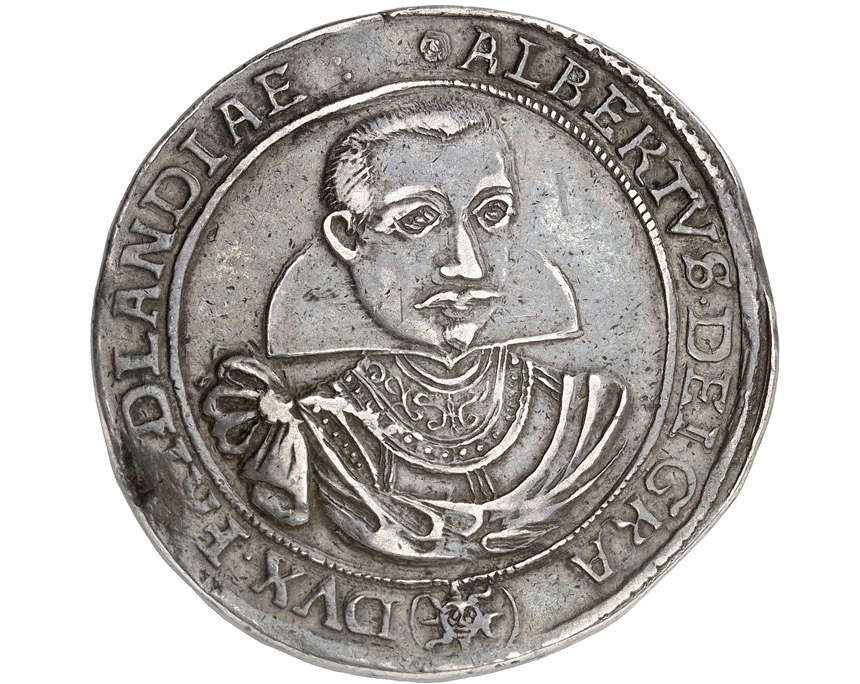Künker’s Fall Auction Sales Achieve a Total Result of 17.3 Million Euros
Künker
Auction 410-414
Coins
23-28 September 2024
D-Osnabrück
It was the strongest auction week ever for the Künker auction house in Osnabrück! With a total hammer price of 17.3 million euros, the estimate of 10 million euros for the 3,900 lots in five auction catalogs was exceeded by more than 70%. Here are the top hammer prices from the five auctions held between 23 and 28 September.
In this review, we present:
- the five most expensive pieces of the auction week as a whole,
- the three most expensive pieces of the Beuth Collection of Dutch coins,
- the three most expensive lösers from the Regina Adams Collection,
- the three most expensive Double Eagles,
- the three most expensive pieces of the Gaiser Collection of Württemberg coinage,
- the three most expensive lots of catalog 413 with German coins after 1871.
Look forward to spectacular collections, spectacular coins and spectacular results!
The Five Most Expensive Piece of Künker’s Fall Auction Sales 2024
Four of the five most expensive lots of Künker’s Fall Auction Sales 2024 came from auction 410. It featured an exceptional collection of coins and medals relating to the Thirty Years’ War and the Peace of Westphalia. Within hours, the 436 lots estimated at 4.25 million euros were sold at a hammer price of 7.5 million euros – accounting for more than a third of the total result of the auctions.
This came as no surprise to experts, as the anonymous collector had assembled exactly the kind of coins that are so popular around the world today: multiple gold coins of exquisite quality. Therefore, numerous hammer prices in the upper five- and six-figure range were realized: 16 lots fetched more than 50,000 euros each, and six lots reached six-figure sums.
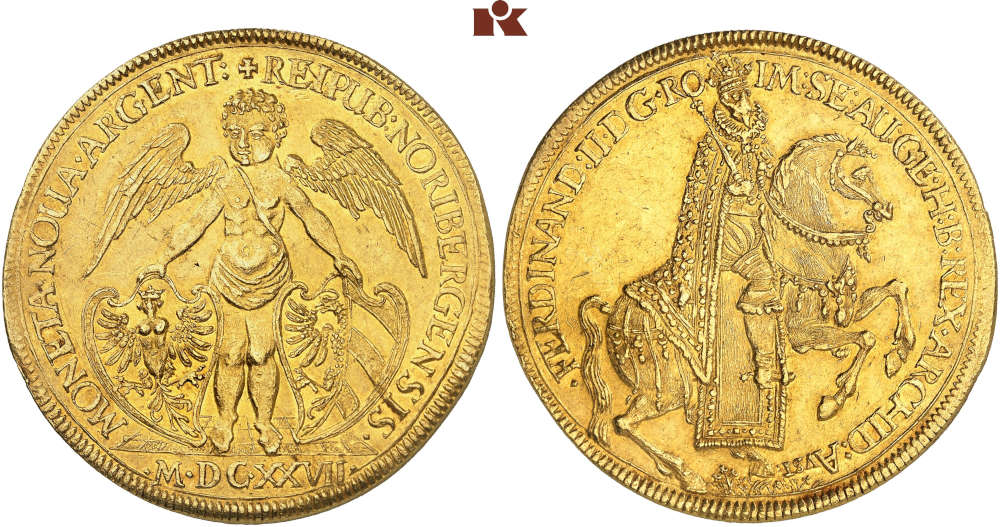
No. 305. Nuremberg. 10 ducats, 1627. Extremely rare. Extremely fine. Estimate: 50,000 euros. Hammer price: 125,000 euros.
Top 5:
Let us start with the 5th place: A 10-fold ducat of the city of Nuremberg jumped from an estimate of 50,000 euros to an impressive 125,000 euros. This was obviously due to its rarity combined with its outstanding condition; but its provenance dating back to 1930 and the detailed depiction of Emperor Ferdinand II on horseback certainly added to the buyer’s enthusiasm.
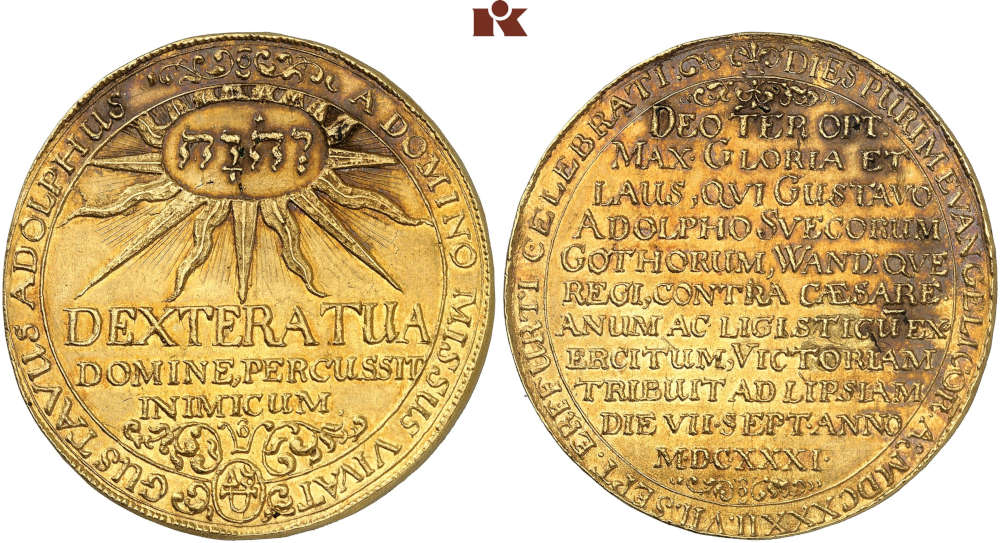
No. 228. Erfurt. Under Swedish rule. Gustav II Adolph, 1631-1632. 10 ducats, 1632. Off-metal strike of the Purim taler. Extremely rare. Extremely fine. Estimate: 40,000 euros. Hammer price: 125,000 euros.
Top 4:
Despite its lower estimate of 40,000 euros, a 1632 off-metal strike in gold of the Erfurt Purim taler with a weight of 10 ducats also realized 125,000 euros. This coin is a propaganda issue minted to celebrate the Swedish victory at Breitenfeld, which is now a district of the city of Leipzig. The victory took place one year earlier, on 17 September 1631. The coin compares the victory of the Swedish king to the biblical rescue of the Jewish people: the Persian official Haman planned to have every single Jew killed in a single day – but his plan was thwarted by Esther. In fact, the intervention of Gustav II Adolph cannot be compared to Esther’s rescue of the Jewish people. The Swedish ruler had not protected the Protestant religion – he had merely protected Protestant rulers from having to return the property that they had seized from the Catholic Church.
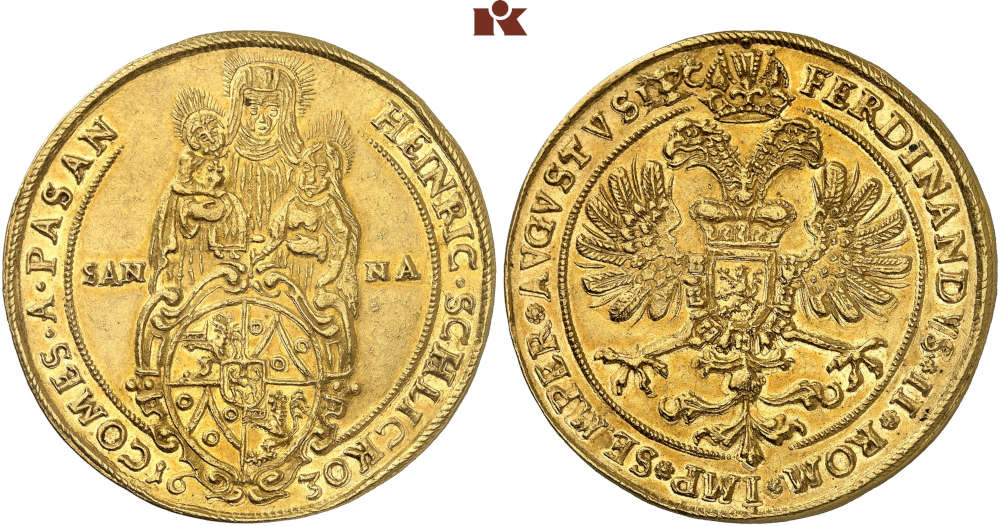
No. 142. County of Schlick (Šlikové). Heinrich IV, 1612-1650. 10 ducats, 1630. Unique. Extremely fine. Estimate: 100,000 euros. Hammer price: 140,000 euros.
Top 3:
Just one year earlier, Heinrich IV of Schlick of Bassano and Weisskirchen issued a 10-fold ducat, of which only a single piece is known to exist – the specimen offered at Künker. That is why the coin had an impressive estimate of 100,000 euros. It sold for 140,000 euros.
The coin is of great historical interest as it documents the careers that members of rather unimportant side-branches of old ruling houses could make during the Thirty Years’ War – provided that they were on the winning side. Heinrich IV of Schlick converted to Catholicism in 1622, became an important military commander in the imperial army, and was rewarded by Ferdinand II with lands that Ferdinand II had confiscated from another branch of the House of Schlick during the Bohemian Revolt. In 1622, Heinrich of Schlick even became President of the Imperial War Council (Hofkriegsratspräsident), an office equivalent to that of Secretary of Defence today.
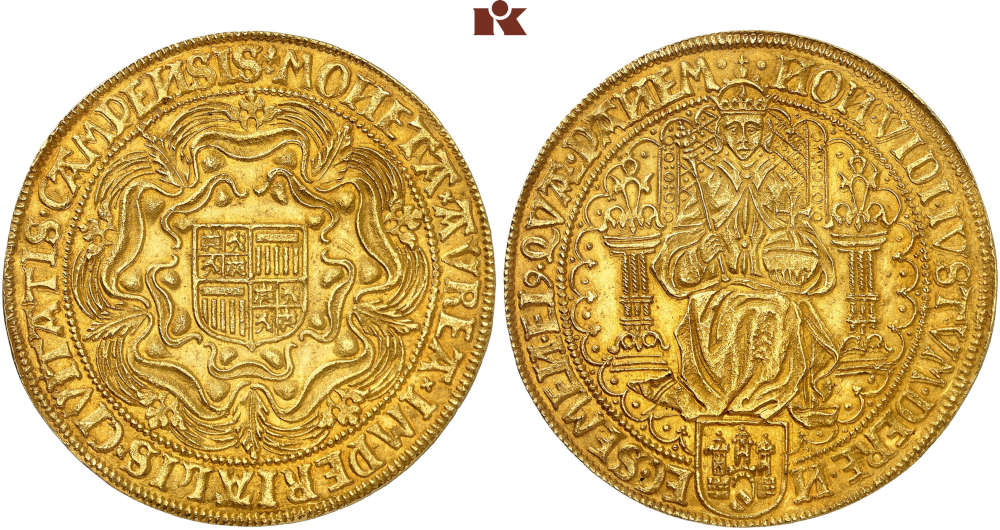
No. 5055. Netherlands. / Campen. Double rose noble n.d. (c. 1600). Imitation of a sovereign by Queen Elizabeth of England. Only 5-6 specimens known to exist. Extremely fine. Estimate: 75,000 euros. Hammer price: 175,000 euros.
Top 2:
Only one of the five most expensive coins in the auction week is not from auction 410, namely the double rose noble, minted around 1600 by the town of Campen. It is a local imitation of the sovereign of Queen Elizabeth of England. The coin is part of the Lodewijk S. Beuth Collection and one of the great rarities of Dutch numismatics.
The Künker auction house is proud to have sold the double rose noble for 175,000 euros, having already sold an eightfold rose noble from the Salton Collection for 700,000 euros in 2022. According to Coinarchives, this is the highest sum ever achieved at auction for a double rose noble from Campen.

No. 425. Wallenstein. 1627 double reichstaler, Jitschin. Very rare. Very fine. Estimate: 50,000 euros. Hammer price: 180,000 euros.
Top 1:
Impressive 180,000 euros – that is the hammer price of the double reichstaler of Albrecht von Wallenstein, struck in Jitschin in 1627. It was lot number 425 in auction 410 and the most expensive piece sold in the entire auction week. At the same time – according to Coinarchives – it is the most expensive silver coin by Albrecht von Wallenstein to be ever sold at auction.
The result demonstrates how popular the coins of this commanding general of the armies of the Holy Roman emperor are. People have been fascinated by Wallenstein’s fate – from a coin entrepreneur to a general whose power rivalled that of the emperor, to his sudden and surprising fall – even before Friedrich Schiller wrote his popular Wallenstein trilogy. That is why the coins of Albrecht von Wallenstein are sure to fetch extremely high prices.
Coins of the Netherlands: The Lodewijk S. Beuth Collection, Part 2
Having already presented the most expensive coin of the Lodewijk S. Beuth Collection, the second part of which was offered in auction 414, we would like to highlight the other two lots in the top three of this collection. They represent an exceptionally strong sale: the 1,237 lots with a total estimate of 800,000 euros jumped to 2.4 million euros, more than three times their estimate.
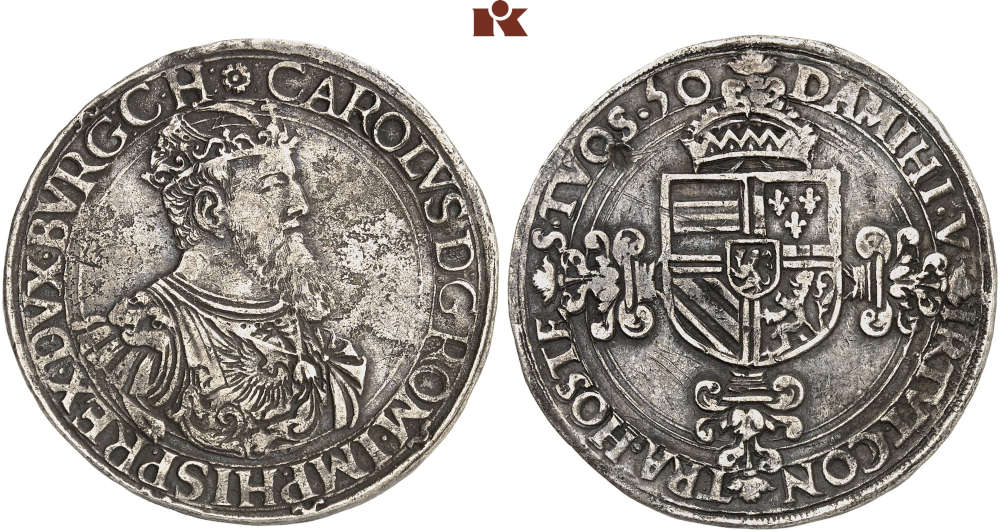
No. 4335: Holland. Charles V, 1506-1555. Silver carolusgulden. Probably the second known specimen. Very fine. Estimate: 5,000 euros. Hammer price: 46,000 euros.
Top 3:
The high result of the silver carolusgulden from 1550, minted in Dordrecht, demonstrates that the coin market is not only dominated by investors. After all, this coin combines all the features that investors do not like: it has traces of corrosion, small dents and is “only” of very fine quality. However, it takes us back to a fascinating period in Dutch numismatics. It shows a portrait of Charles V as Count of Holland. Under the rule of his son Philip II, the province rebelled and become one of the leading powers in the struggle for independence. Representing an important chapter in Dutch history and being an exceptional rarity – only one other specimen is known to exist – the coin encouraged numerous bidders to try to get their hands on this relic of Dutch numismatics. They made this piece jump from an estimate of 5,000 euros to a hammer price of 46,000 euros!
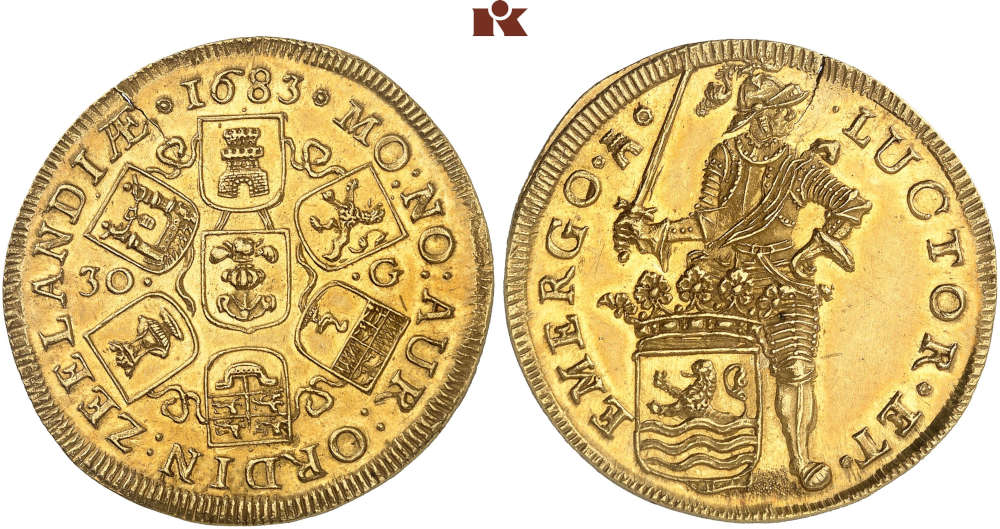
No. 4598: Zeeland. 30 guldens, 1683, Middelburg. Extremely rare. Extremely fine +. Estimate: 25,000 euros. Hammer price: 70,000 euros.
Top 2:
In second place, once again, we find a multiple gold coin of exceptional quality – a 30-fold gulden of the Province of Zeeland in extremely fine + quality. At an estimate of 25,000 euros and a result of 70,000 euros, it was the second most expensive piece in auction 414.
Lösers from the Regina Adams Collection
Let us take a look at the results of the lösers from the Regina Adams Collection. The collector specialized in specimens of outstanding quality and this was reflected in the hammer prices.
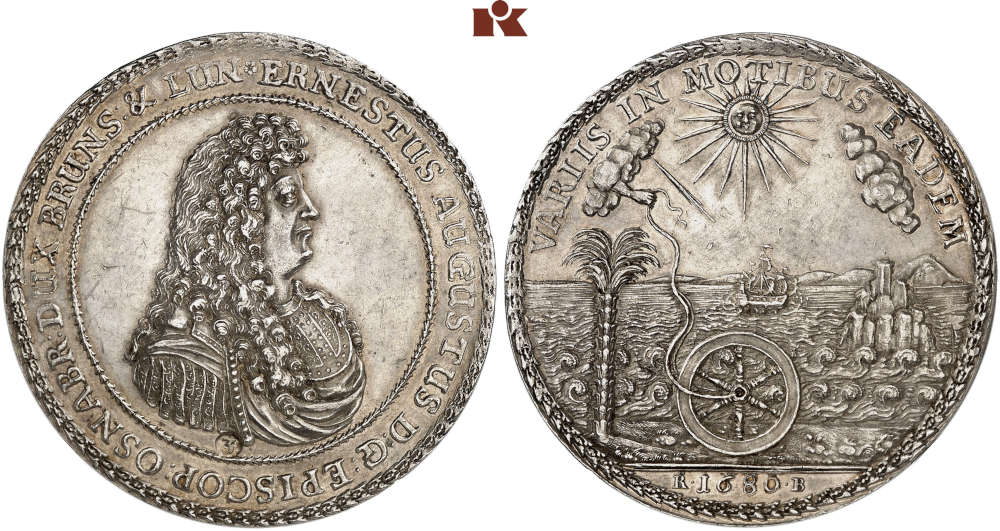
No. 1565: Brunswick-Calenberg-Hanover. Ernest Augustus, 1679-1698. 1680 löser of 3 reichstalers, Zellerfeld. Extremely rare. Extremely fine. Estimate: 10,000 euros. Hammer price: 34,000 euros.
Top 3:
In 3rd place and with a hammer price of 34,000 euros, we have a löser of 3 reichstalers that translated the motto of Duke Ernest Augustus into a coin: variis in motibus eadem. In English, it might read “the same in different sentiments”. This message is illustrated by Ernest Augustus’ wheel of fortune, which is held by the hand of God. It is always the same, no matter whether the sun is shining or dark clouds are gathering. The ship of his life is struggling to stay afloat in a stormy sea, and is about to be crushed by a cliff. But in the foreground we can see the tempting date palm. With its rough trunk, which must be overcome in order to reach the sweet dates, it symbolizes the fact that the kingdom of God can only be reached after the hardships of worldly toil. By the way, this emblem can not only be found on coins. Ernest Augustus also used it in other contexts.

No. 1551: Brunswick-Wolfenbüttel. Augustus II the Younger, 1635-1666. Löser of 4 reichstalers, 1666, Zellerfeld, commemorating his death. Extremely rare. Extremely fine. Estimate: 40,000 euros. Hammer price: 44,000 euros.
Top 2:
44,000 euros was the final bid for a löser of 4 reichstalers minted in 1666 on the occasion of the funeral ceremonies in honor of Augustus II the Younger. It is part of one of the largest issues ever struck for a Brunswick duke. Its reverse depicts a withered tree above a skull. The inscription refers to this, it translates as “I who once blossomed in lush foliage now tower bare”. As does the better-known motto: “Sic transit Gloria mundi” (Thus passes the glory of the world). In addition, we can read on the reverse the motto of Augustus II: “always with prudence”. All three Latin mottoes contain a chronogram of the date of death, 1666.
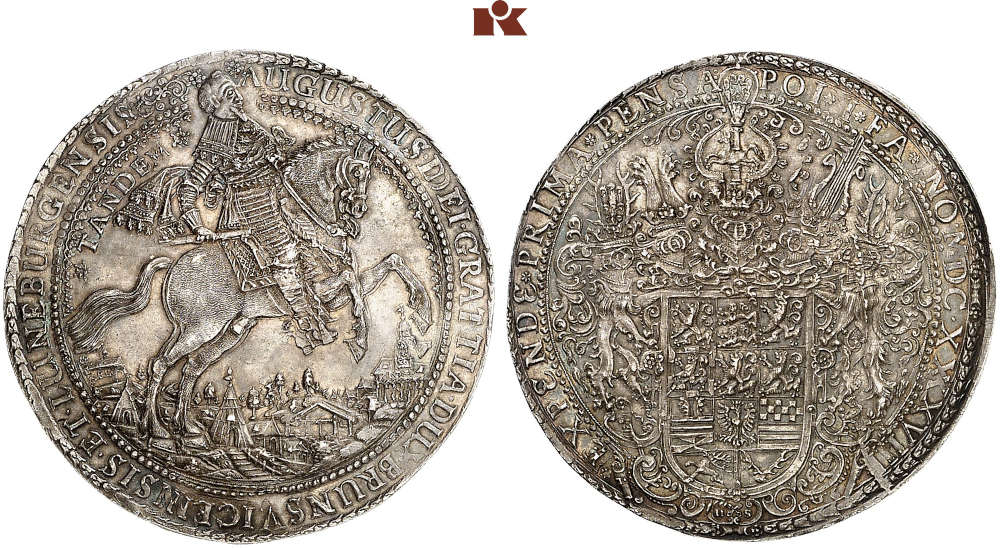
No. 1544: Brunswick-Wolfenbüttel. Augustus II the Younger, 1635-1666. 1638 löser of 5 reichstalers, Zellerfeld, celebrating the emperor’s confirmation of the succession. Extremely rare. Extremely fine to FDC. Estimate: 40,000 euros. Hammer price: 100,000 euros.
Top 1:
The 1638 löser of 5 talers by Augustus the Younger has fascinated collectors right from the beginning due to the incredibly sharp minting and its outstanding condition. It depicts every detail of the carefully composed motif. Therefore, it came as no surprise for this coin to become the most expensive piece in the entire collection. It jumped from an estimate of 40,000 euros to an impressive result of 100,000 euros!
Double Eagles
Künker was delighted to offer an extensive series of almost 200 Double Eagles in auction 412, including numerous rarities. The consignor will be pleased with the results, with the three most expensive pieces all realizing 70,000 euros each. We ranked them based on the difference between their estimate and the hammer price.
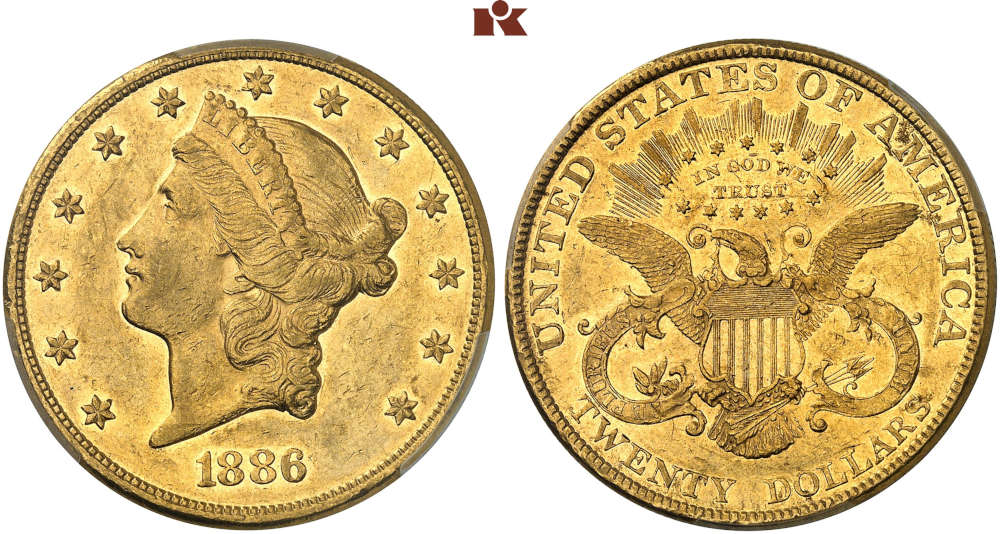
No. 1407: 20 dollars, 1886, Philadelphia. PCGS AU53. Only 1000 specimens minted. About extremely fine. Estimate: 25,000 euros. Hammer price: 70,000 euros.
Top 3
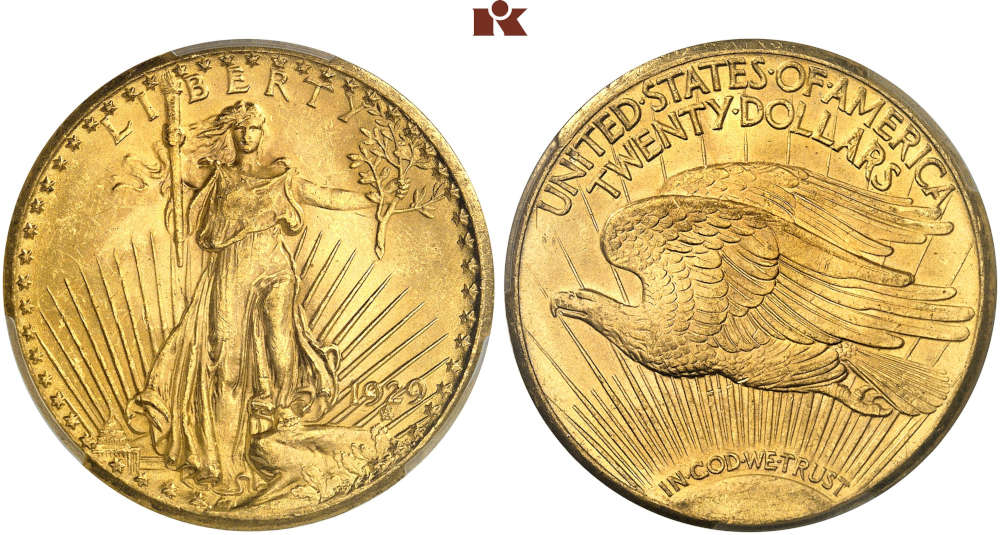
No. 1504: 20 dollars, 1929, Philadelphia. PCGS MS65. Extremely rare. Extremely fine to FDC. Estimate: 20,000 euros. Hammer price: 70,000 euros.
Top 2
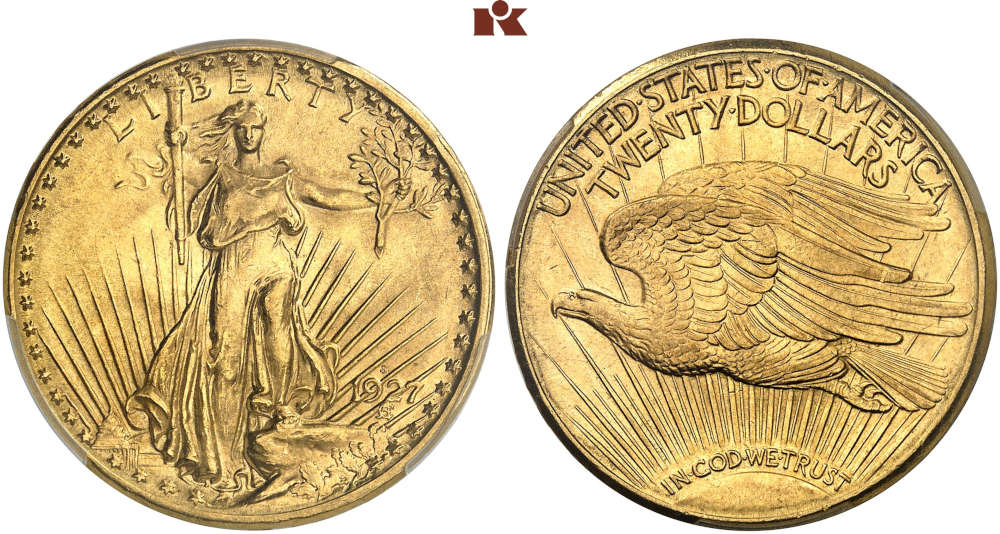
No. 1504: 20 dollars, 1929, Philadelphia. PCGS MS65. Extremely rare. Extremely fine to FDC. Estimate: 20,000 euros. Hammer price: 70,000 euros.
Top 1
Württemberg’s Coinage History: The Heinz-Falk Gaiser Collection, Part 1
German collectors can be pleased about the fact that prices for “their” coins are still rather affordable – at least if you compare them to what buyers are paying for British, US or Italian rarities. This is not to say that the pieces of the Heinz-Falk Gaiser Collection were not successful, on the contrary! The high prices realized by Württemberg coins are truly remarkable. And, of course, there were some particularly high results.
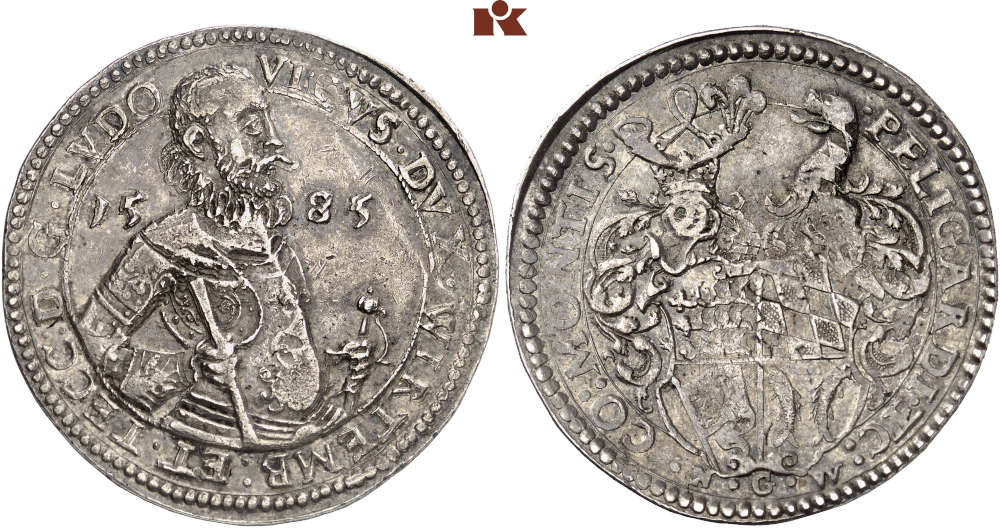
No. 800: Württemberg. Louis III of Württemberg, 1568-1593. 1585 taler, Stuttgart, minted from the silver of the Christophtal mine to celebrate his wedding to Ursula von Pfalz-Veldenz. Only 458 specimens minted. Very fine to extremely fine. Estimate: 15,000 euros. Hammer price: 28,000 euros
Top 3:
Duke Louis of Württemberg had as few as 458 specimens of the 1585 taler minted to be distributed among the guests of his wedding to Ursula von Pfalz-Veldenz. We know this because the duke’s clerk recorded exactly how much silver the St Christophstal mine supplied, how much it cost to produce the coins, and how much the duke earned from them. Given the number of documents and oral histories relating to this piece and its rarity, the 28,000 euros paid for it could be considered a bargain. The estimate had amounted to 15,000 euros.
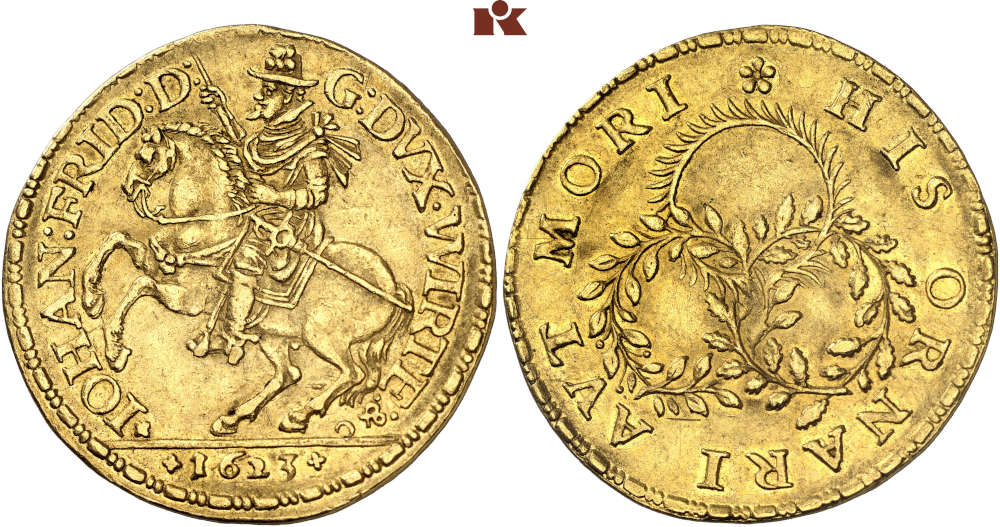
No. 830: Württemberg. John Frederick, 1608-1628. 2 ducats, 1623, Stuttgart, minted to celebrate his being appointed Circle Colonel of the Swabian Circle in 1622. Very rare. About extremely fine. Estimate: 15,000 euros. Hammer price: 32,000 euros.
Top 2:
A double ducat minted by John Frederick of Württemberg to mark his appointment as Colonel of the Swabian Circle sold for 32,000 euros, while its estimate had been 15,000 euros. With its motto and emblem, and a beautiful depiction of the ducal horseman holding the commando baton in his right hand, this coin is a wonderful and highly interesting collector’s item.
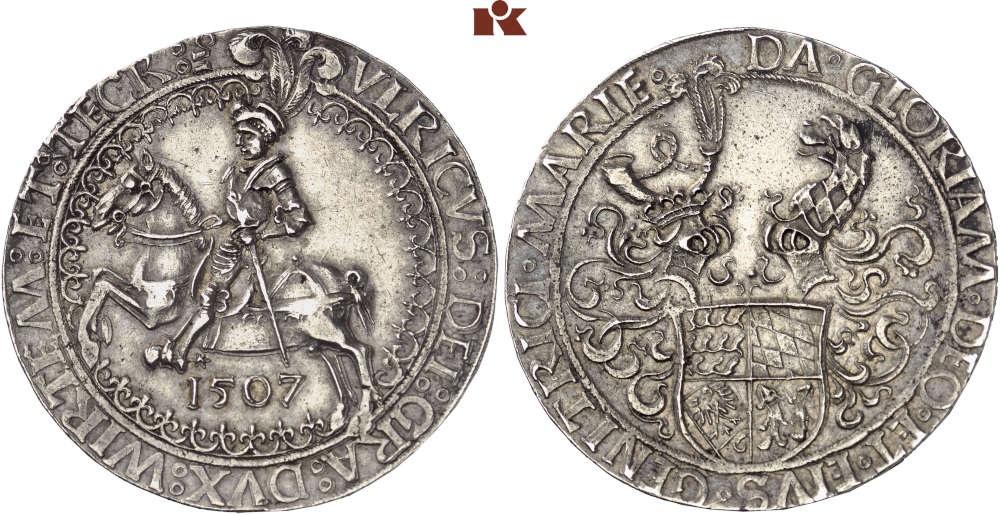
No. 769: Württemberg. Ulrich, 1498-1550. 1507 taler, Stuttgart. “Reitertaler” (horseman taler). Very rare. Probably the finest specimen in private possession. Extremely fine. Estimate: 30,000 euros. Hammer price: 85,000 euros.
Top 1:
85,000 euros was the hammer price for what is probably the most impressive piece in auction 411: a 1507 horseman taler – an icon of Württemberg numismatics. It is a magnificent Renaissance issue, and the beauty of its engraving can well compete with that of any medal. In addition, the coin offered at Künker was the finest specimen of this type in private possession.
Coins of the German Empire
Let us conclude this review with the three most expensive coins of auction 413 focusing on German coins minted after 1871. The great rarities of the German Empire are still comparably affordable, considering the low mintages that are given by Jaeger.
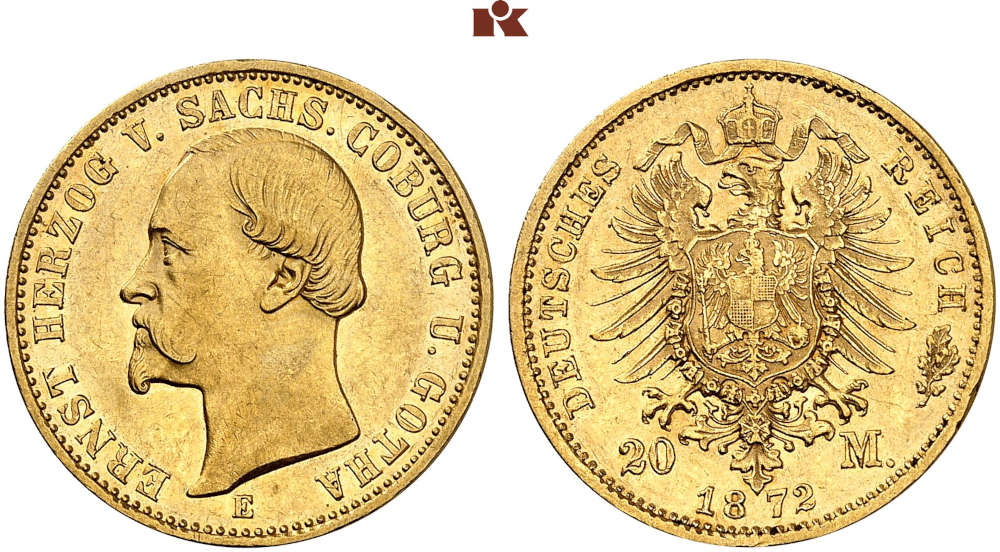
No. 3272: Saxe-Coburg and Gotha. Ernest II, 1844-1893. 20 marks, 1872. Very rare. Above-average quality. About extremely fine. Estimate: 50,000 euros. Hammer price: 60,000 euros.
Top 3
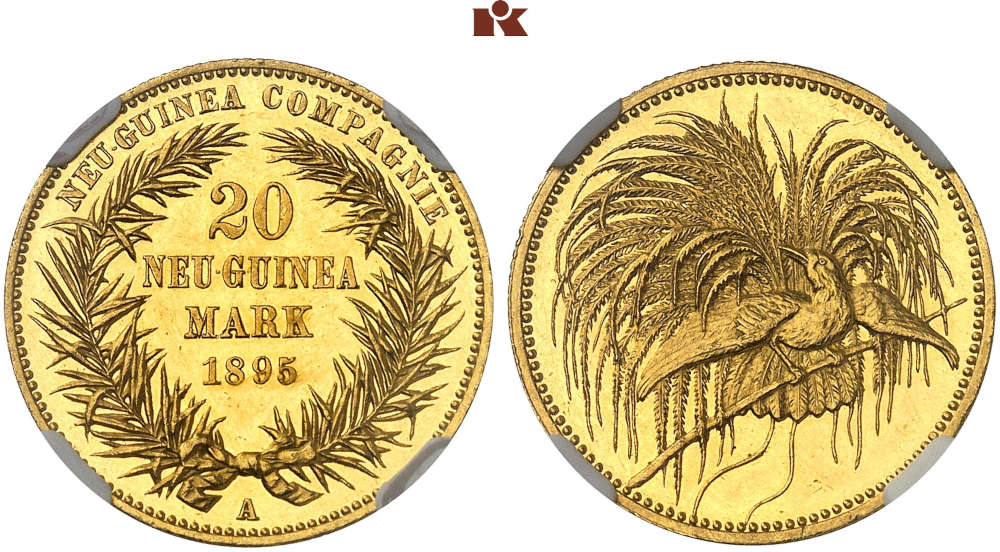
No. 3360: German New Guinea. 20 New Guinean marks, 1895. Only 1500 specimens minted. NGC PF64 CAMEO. Proof. Estimate: 50,000 euros. Hammer price: 75,000 euros.
Top 2
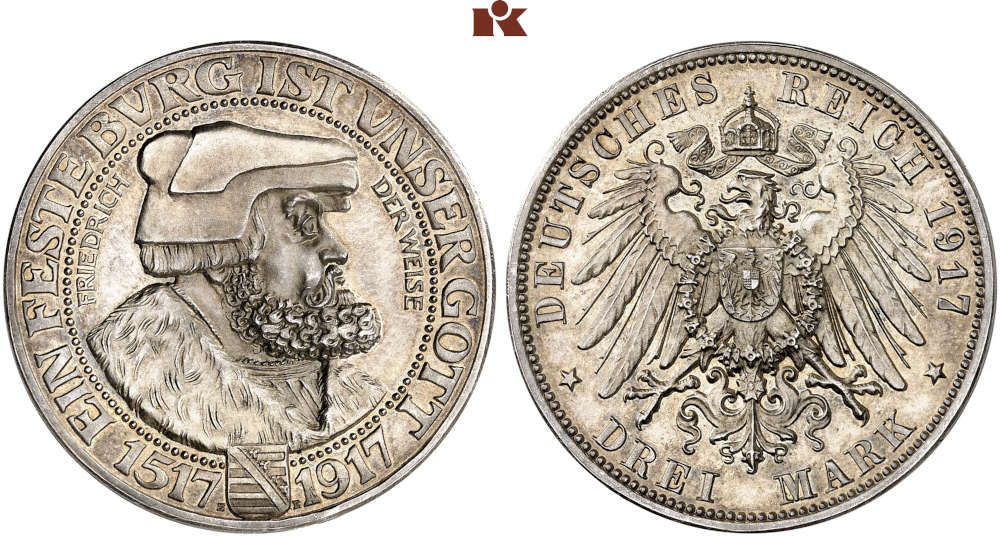
No. 2823: Saxony. 3 marks, 1917 E, “Frederick the Wise”. On the 400th Reformation Jubilee. Very rare. Proof. Estimate: 100,000 euros. Hammer price: 110,000 euros.
Top 1
These were just some of the spectacular results of auctions 410 to 414. Other coins sold for significantly less money. Why don’t you take a look at all the auction results? It is always a surprise to see how much history can be bought for little money.
You can find all auction results online at www.kuenker.de/en. If you have any questions, please do not hesitate to contact Künker, Nobbenburger Str. 4a, 49076 Osnabrück; phone: +49 541 / 962020; fax: +49 541 / 9620222; or via e-mail.

















